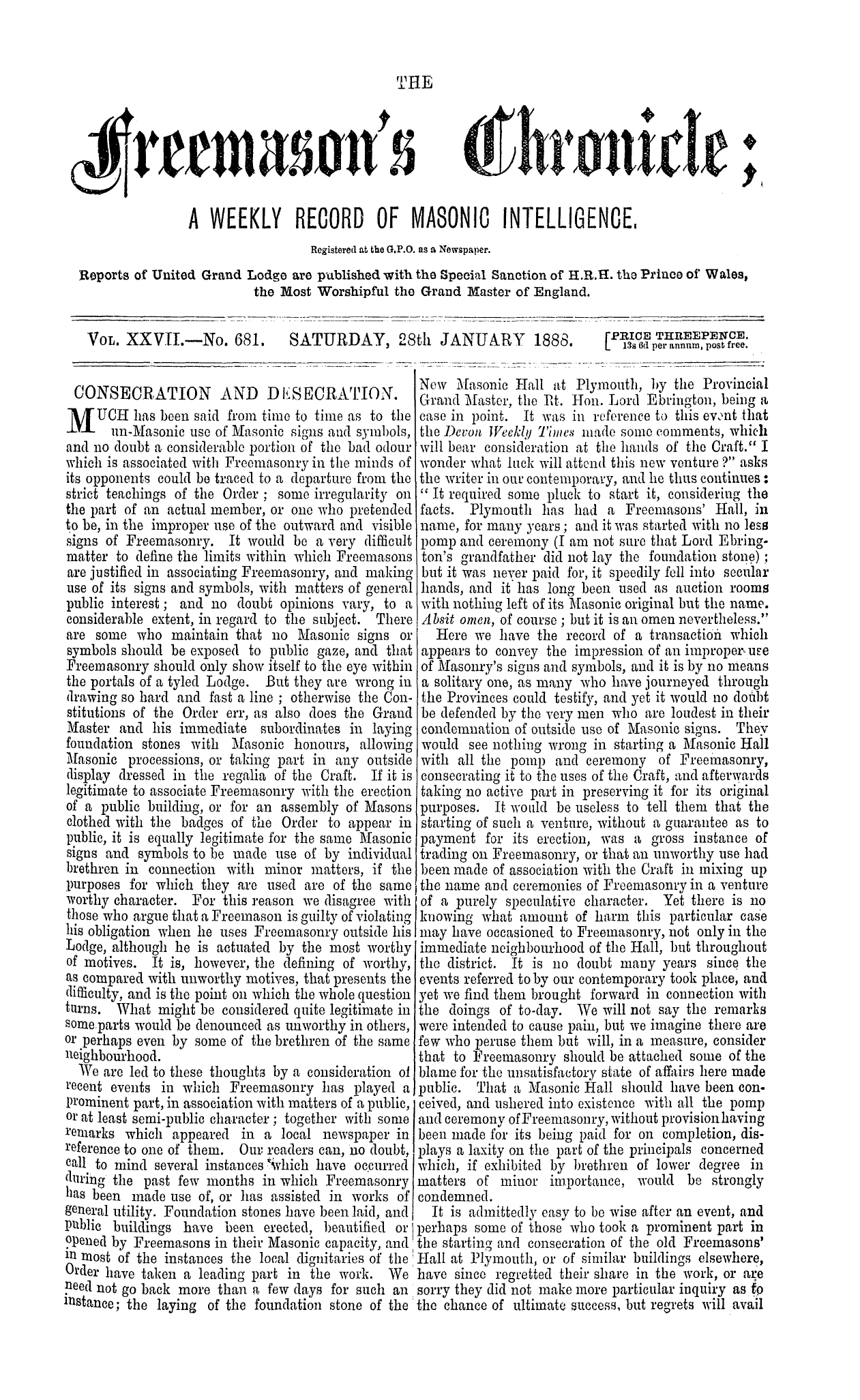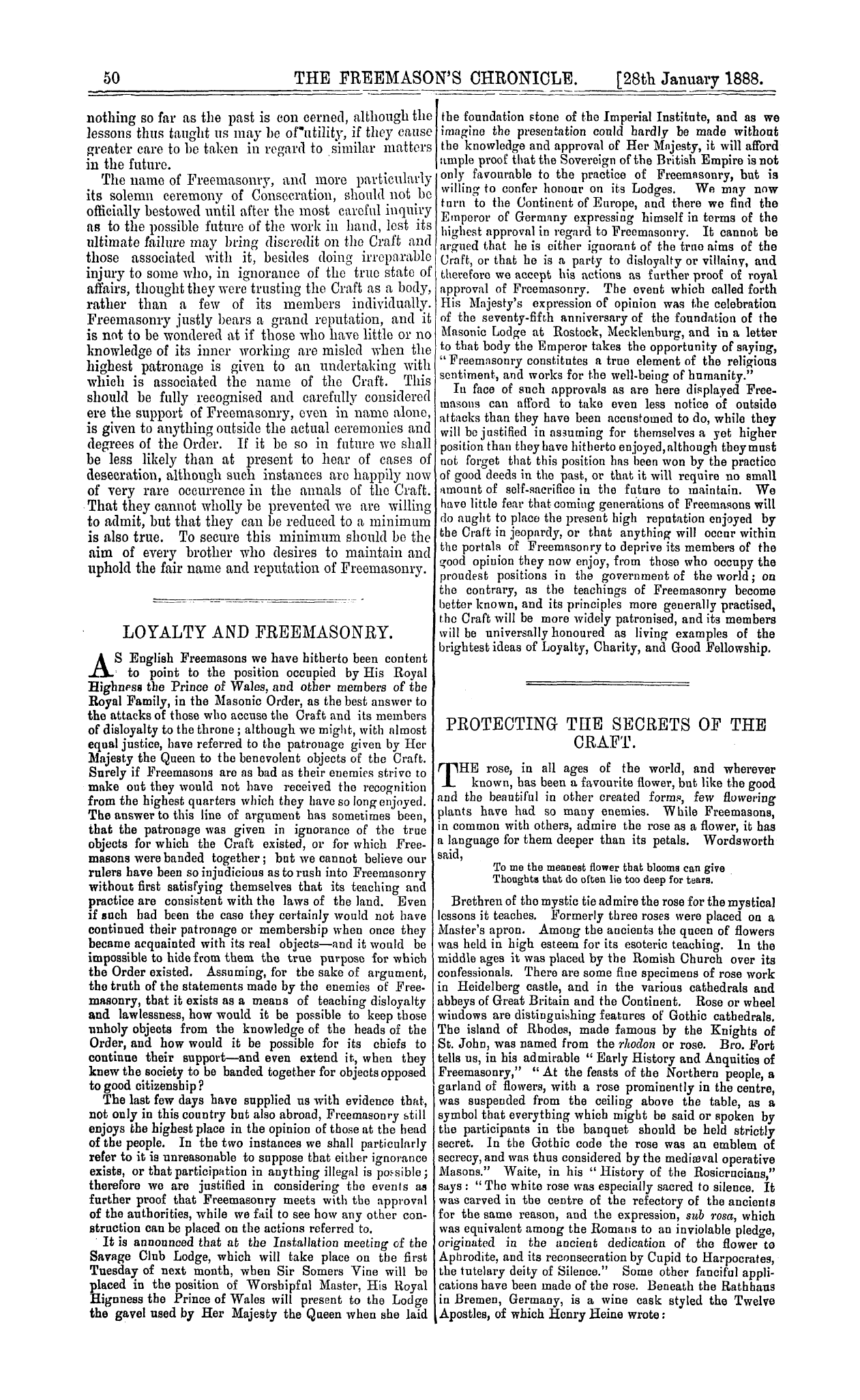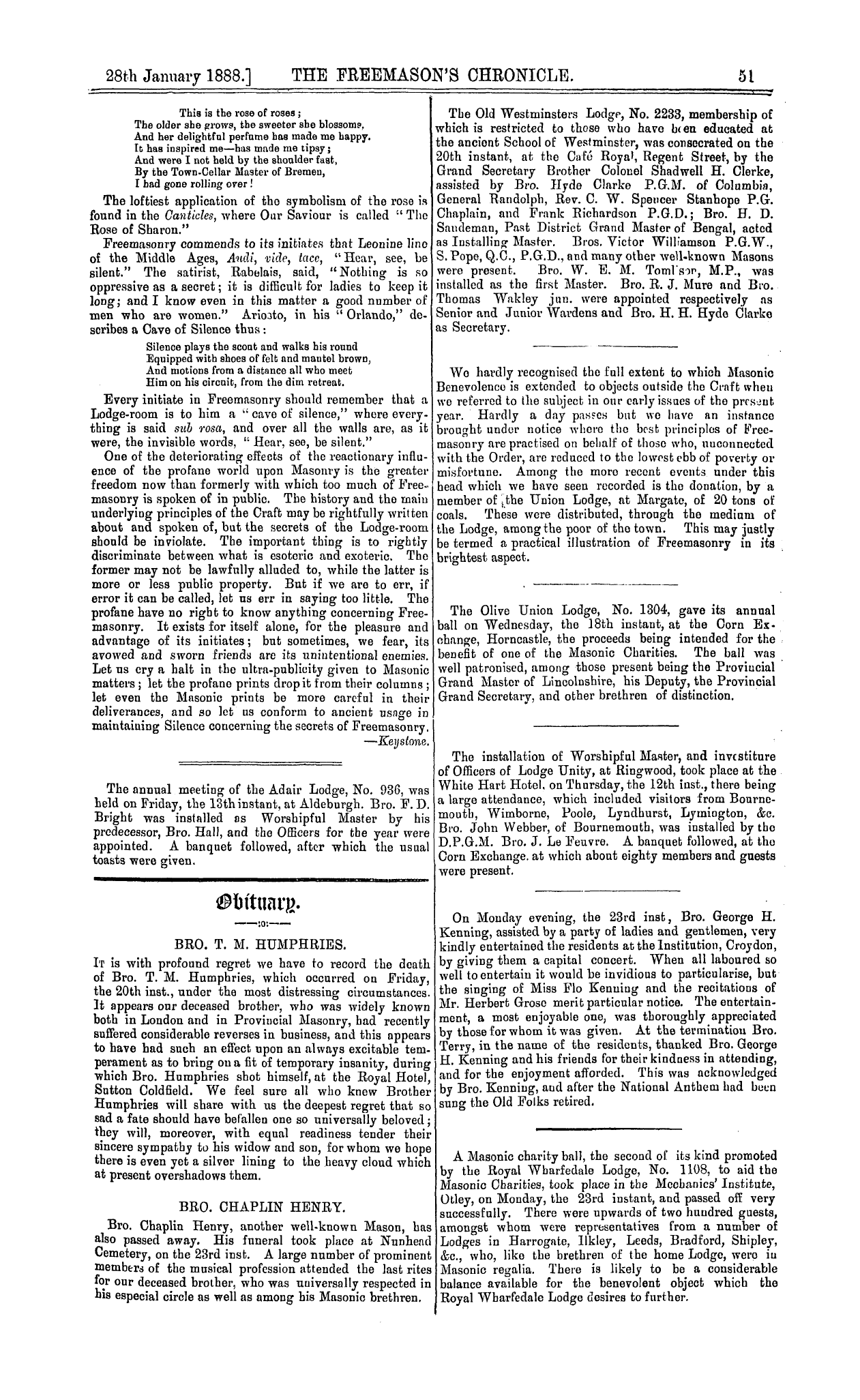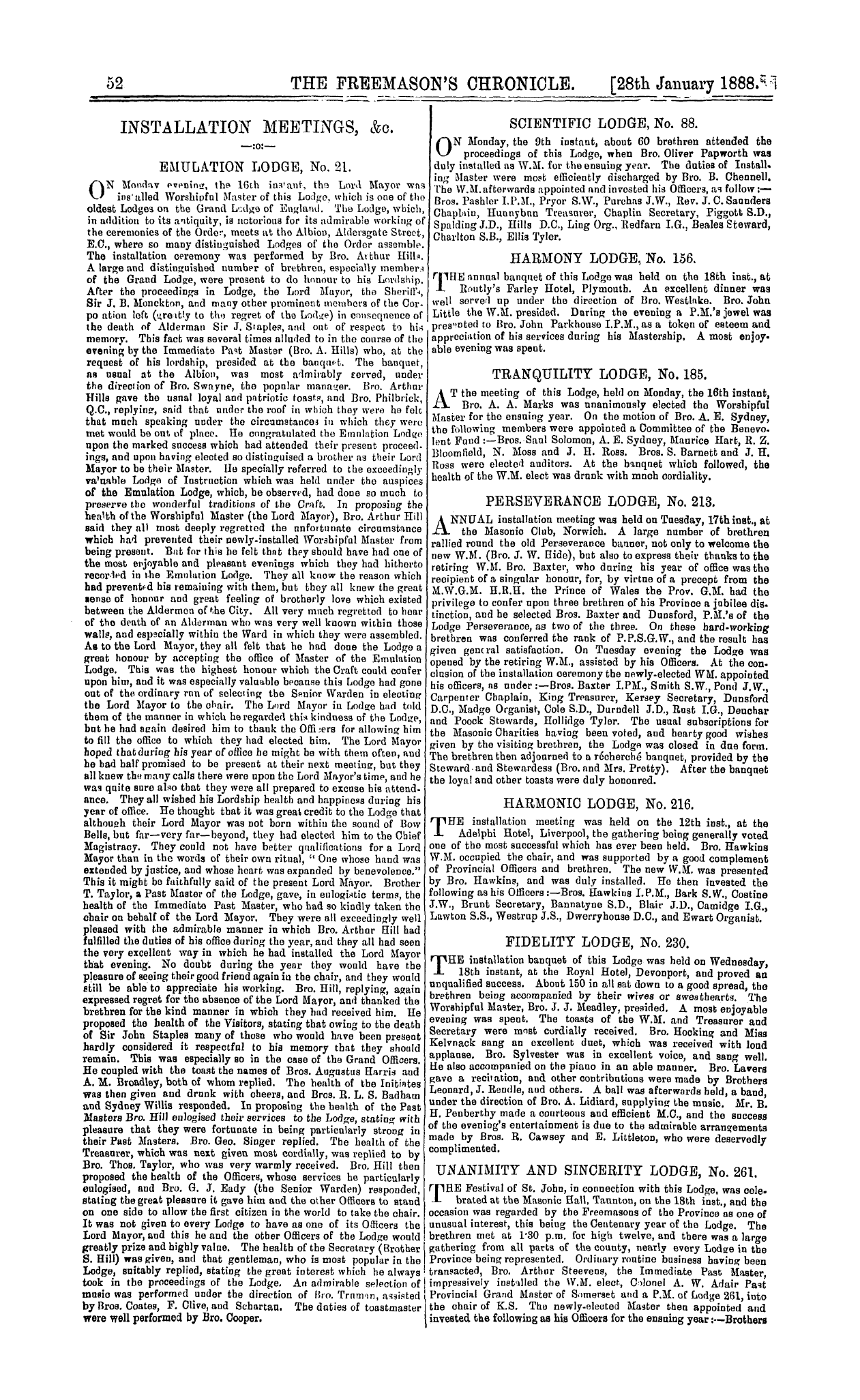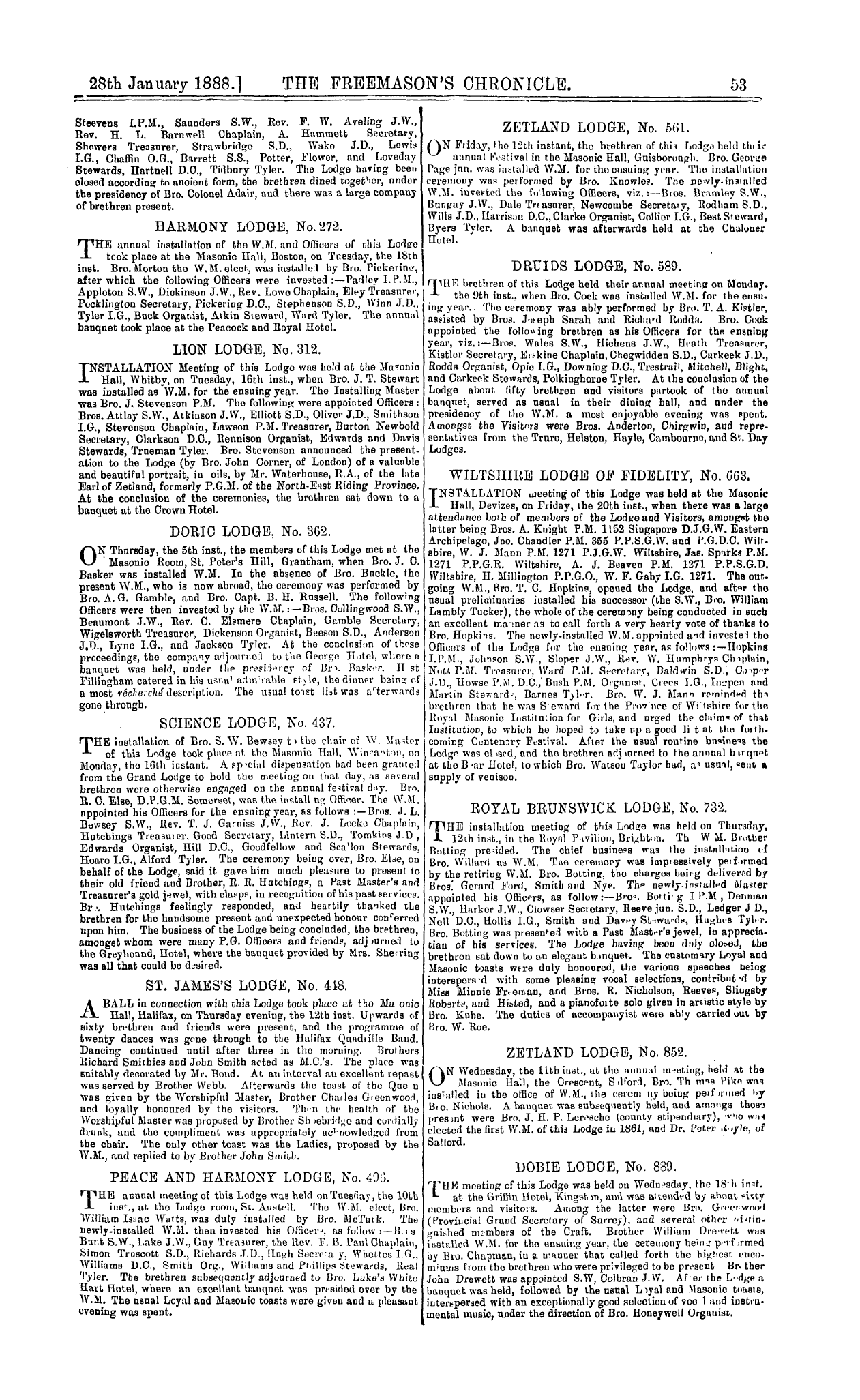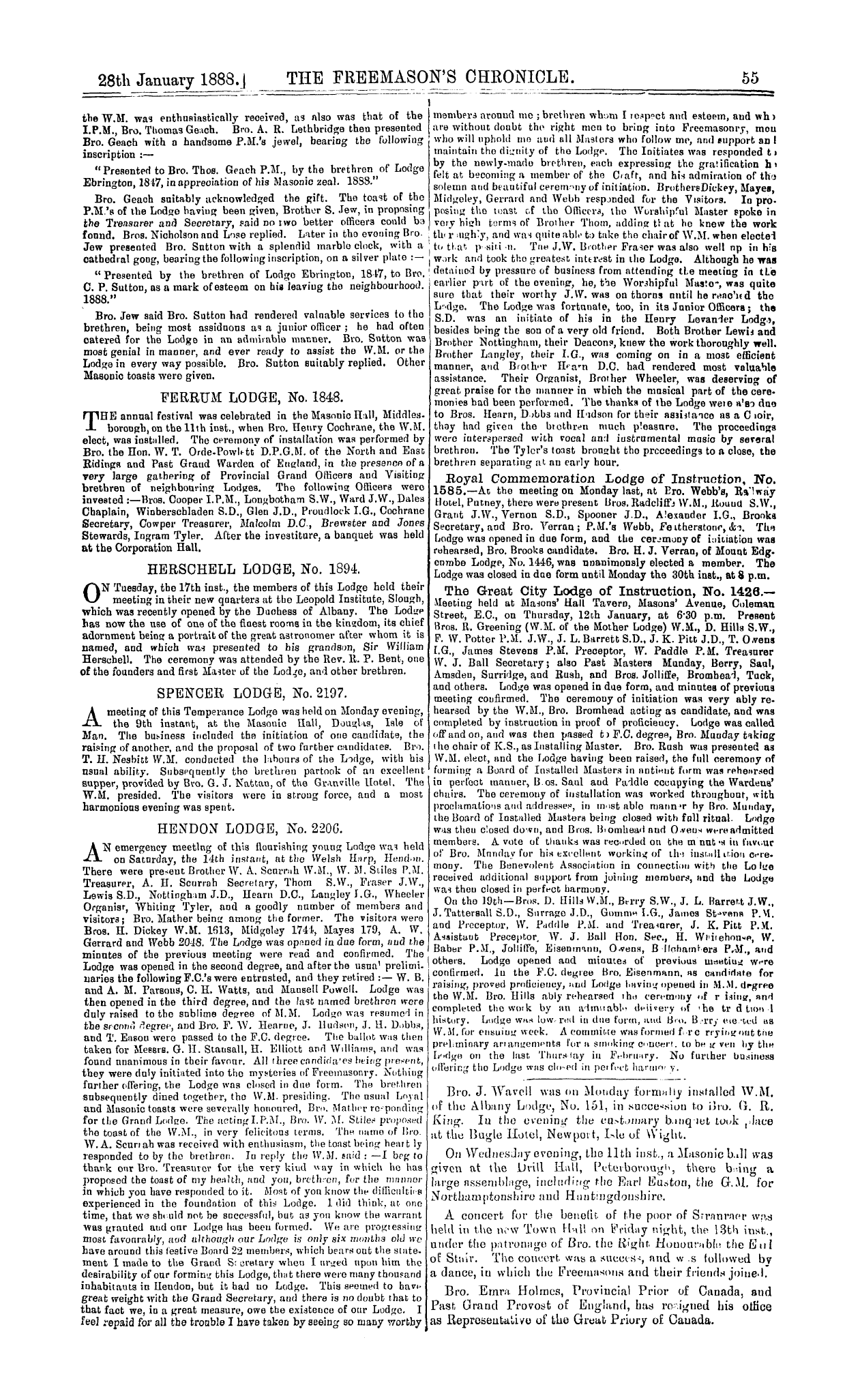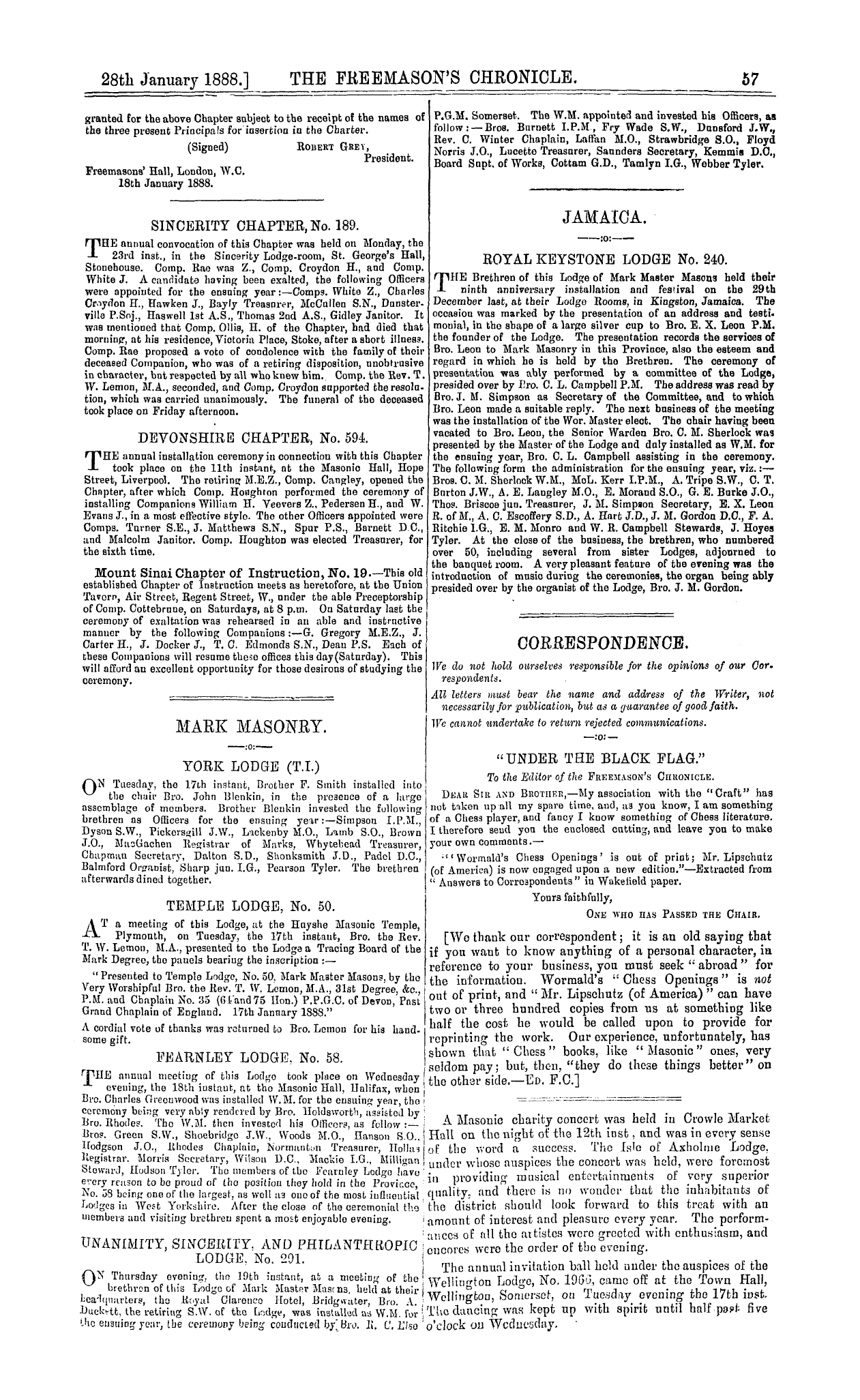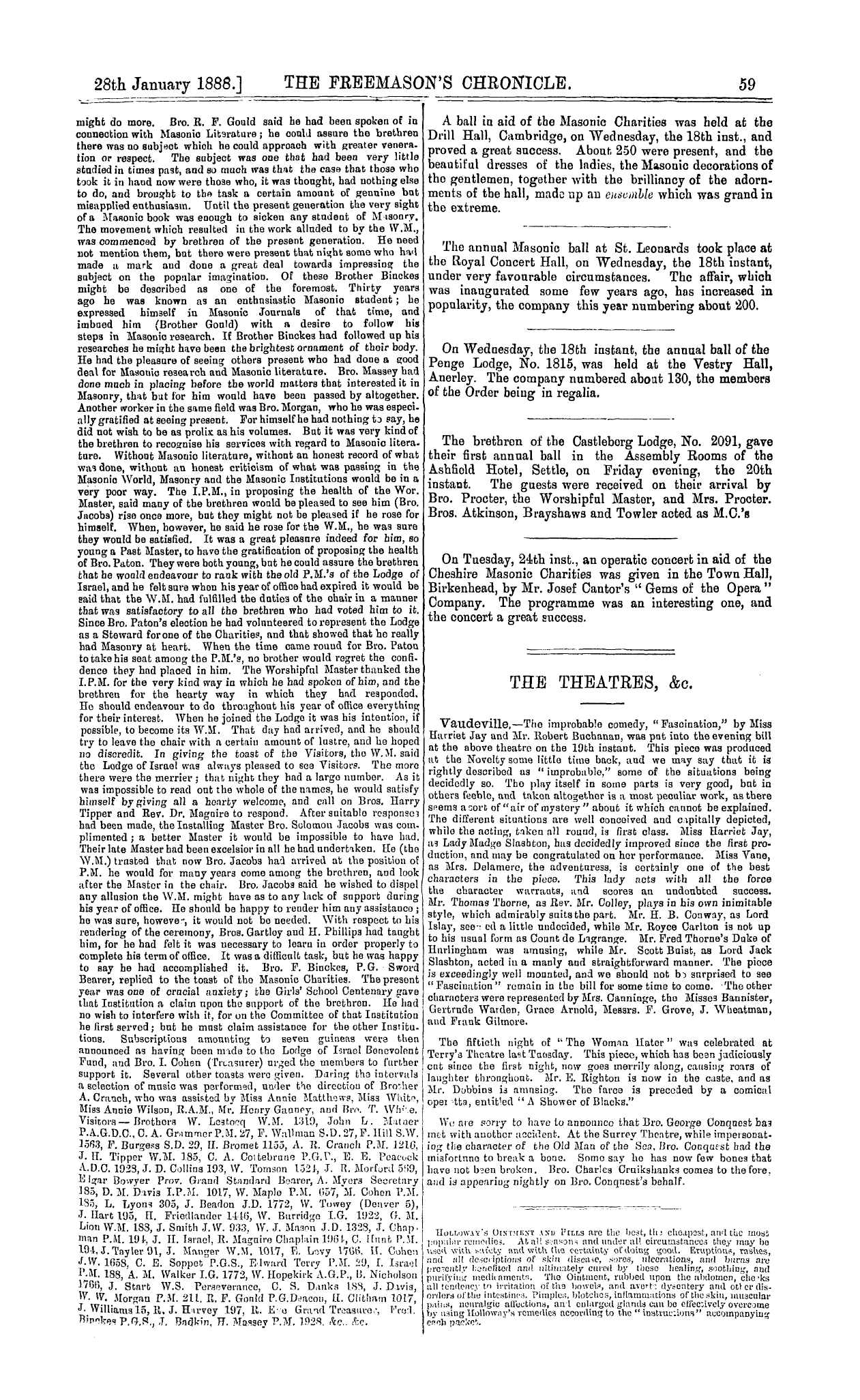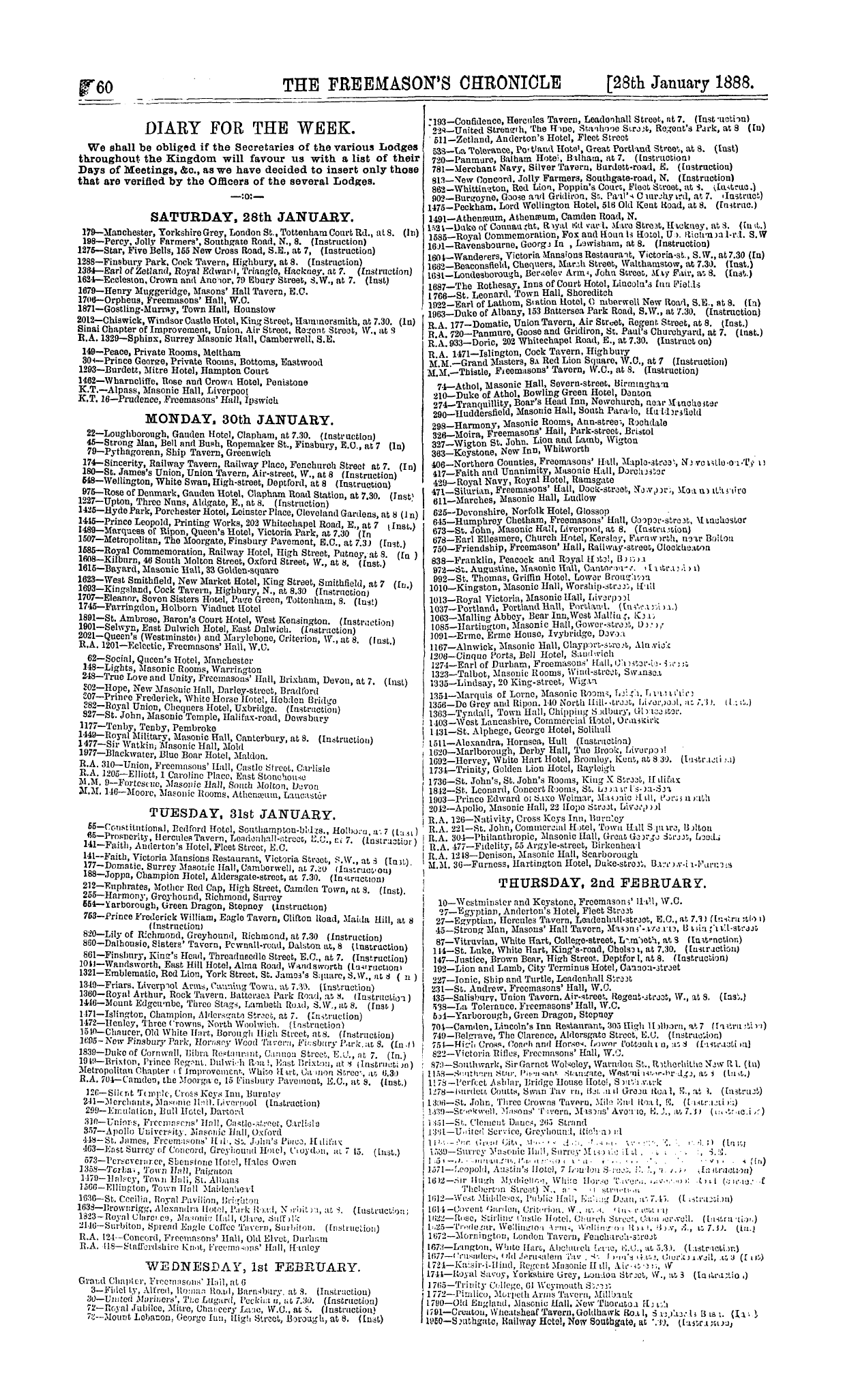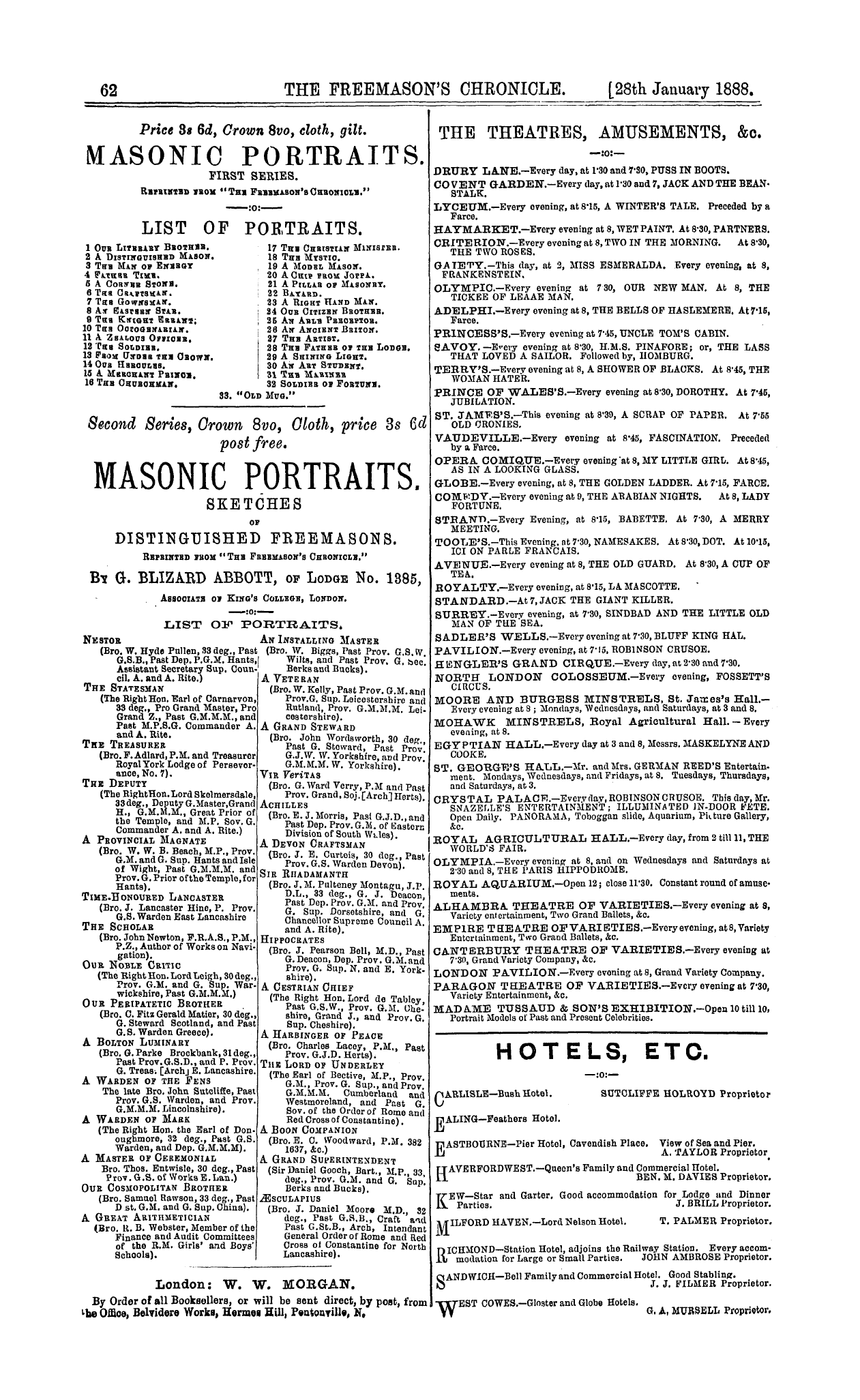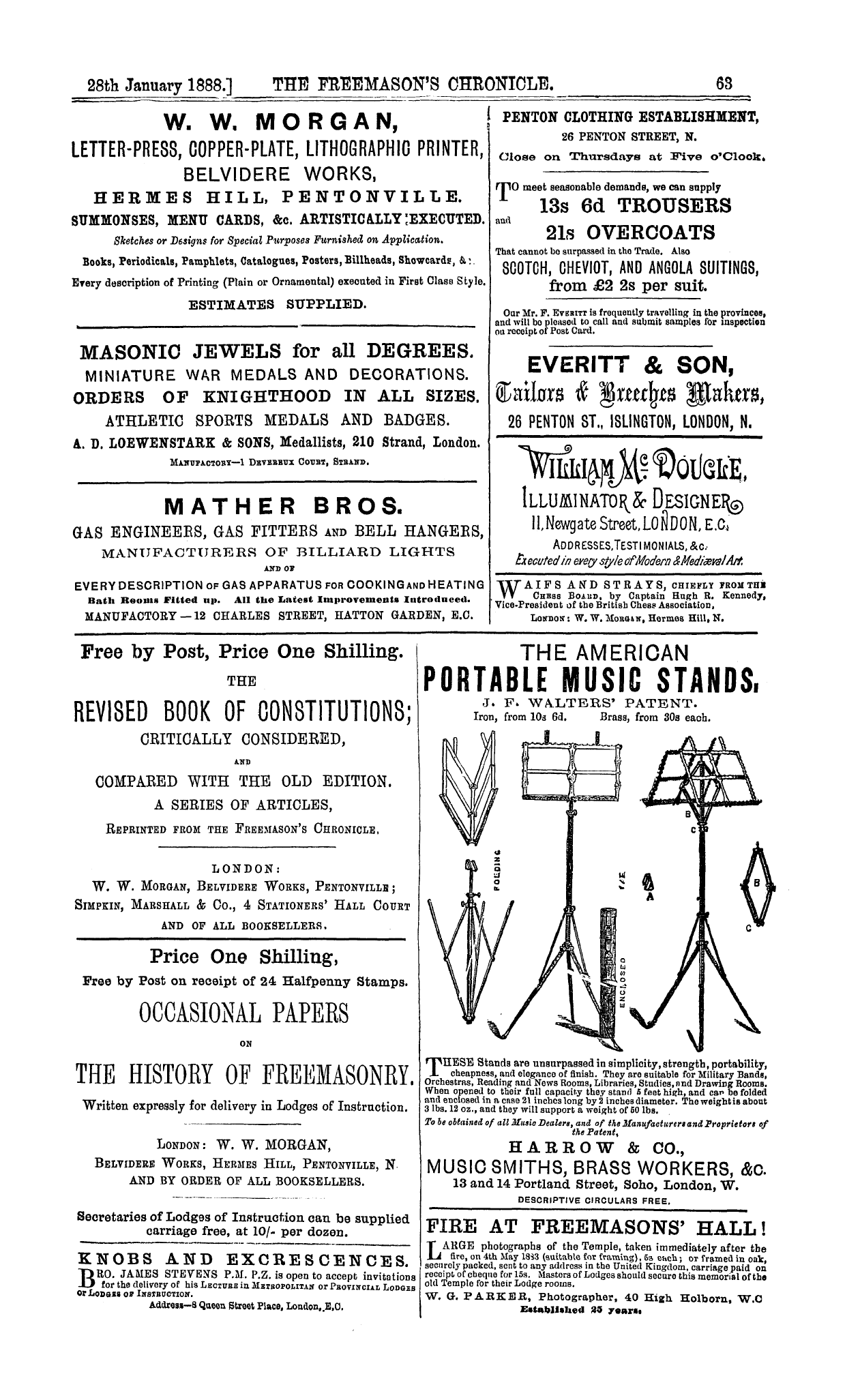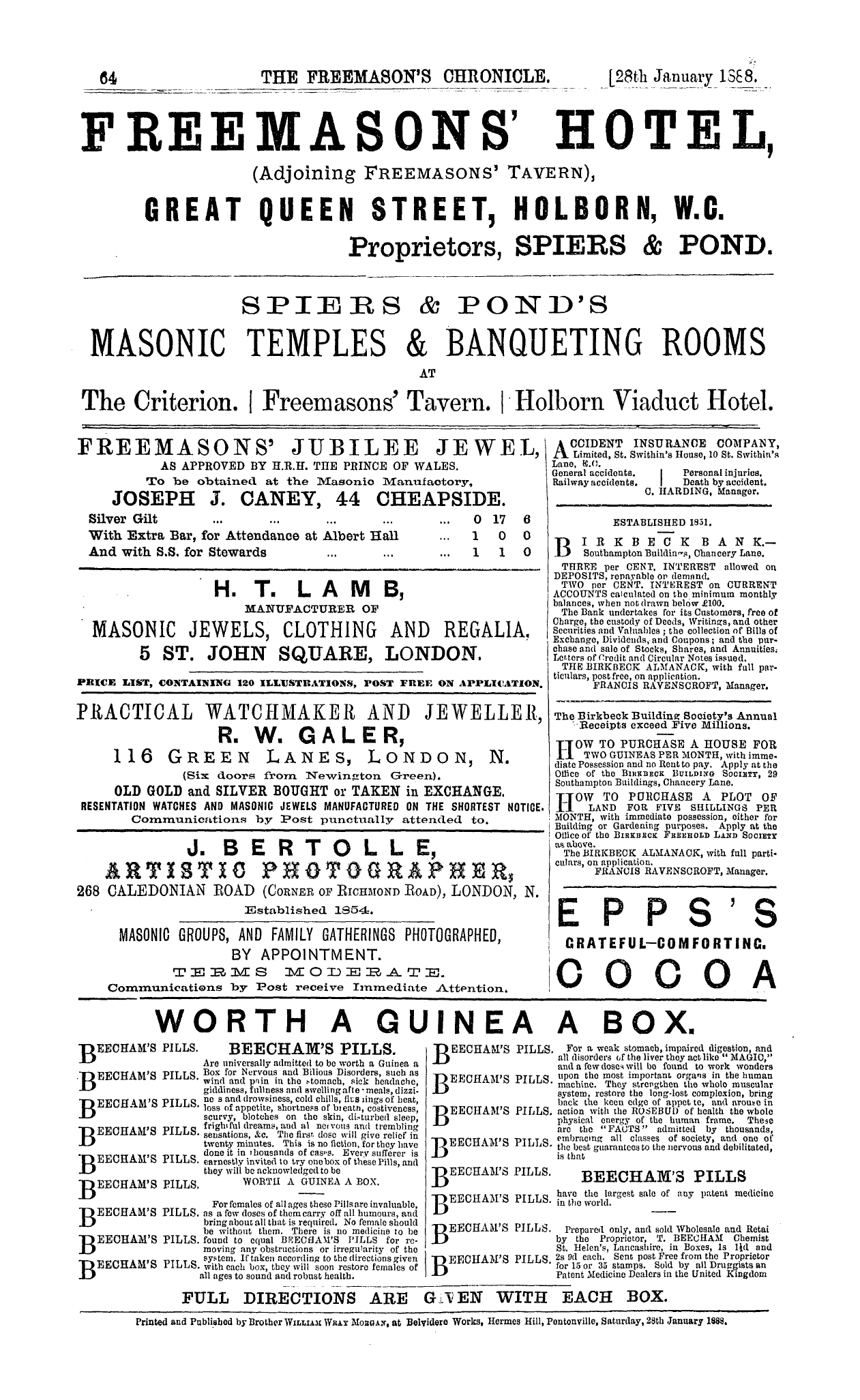-
Articles/Ads
Article CONSECRATION AND DESECRATION. ← Page 2 of 2 Article LOYALTY AND FREEMASONRY. Page 1 of 1 Article LOYALTY AND FREEMASONRY. Page 1 of 1 Article PROTECTING THE SECRETS OF THE CRAFT. Page 1 of 2 →
Note: This text has been automatically extracted via Optical Character Recognition (OCR) software.
Consecration And Desecration.
nothing so far as the past is con eerned , although the lessons thus taught us may be ofutility , if they cause greater care to be taken in regard to similar matters in the future .
The name of Freemasonry , and more particularly its solemn ceremony of Consecration , should not be officially bestowed until after the most careful inquiry as to the possible future of the work in hand , lest its ultimate failure may bring discredit on the Craft and
those associated with it , besides doing irreparable injury to some who , in ignorance of the true state of affairs , thought they were trusting the Craft as a body , rather than a few of its members individually . Freemasonry justly bears a grand reputation , and it is not to be wondered at if those who have little or no knowledge of its inner working are misled when the
highest patronage is given to an undertaking with which is associated the name of the Craft . This should be fully recognised and carefully considered ere the support of Freemasonry , even in namo alone , is given to anything outside the actual ceremonies and decrees of the Order . If it be so in future we shall
be less likely than at present to hear of cases of desecration , although such instances aro happily now of very rare occurrence in the annals of the Craft . That they cannot wholly be prevented we are willing to admit , but that they can be reduced to a minimum is also true . To secure this minimum should be the aim of every brother who desires to maintain and uphold the fair name and reputation of Freemasonry .
Loyalty And Freemasonry.
LOYALTY AND FREEMASONRY .
AS English Freemasons we have hitherto been content to point to the position occupied by His Royal
Hig hnpsa tbe Prince of Wales , and other members of the Boyal Family , in the Masonic Order , as the best answer to tho attacks of those who accuse the Craffc and its members of disloyalty to the throne ; although we might , wifch almost
equal justice , have referred to the patronage given by Her Majesty the Queen to the benevolent objects of the Craft . Surely if Freemasons aro as bad as their enemies strive to make out they would not have received the recognition
from the highest quarters which they have so long enjoyed . The answer to this line of argument has sometimes been , thafc the patronage was given in ignorance of the true objects for which the Craft existed , or for which
Freemasons were banded together ; but we cannot believe our rulers have been so injudicious as to rush into Freemasonry without first satisfying themselves that its teaching and practice are consistent with the laws of the land . Even
if snch had been the case they certainly would not have continued their patronage or membership when once they became acquainted with its real objects—and it would be impossible to hide from them the true purpose for which
the Order existed . Assuming , for tbe sake of argument , the truth of the statements made by the enemies of Freemasonry , that it exists as a means of teaching disloyalty and lawlessness , how would it be possible to keep those unholy objects from the knowledge of the heads of the
Order , and how would it be possible for its chiefs to
continue their support—and even extend it , when they knew the society to be banded together for objects opposed to good citizenship ? The last few days have supplied us with evidence that
not only in this country but also abroad , Freemasonry still enjoys the highest place in the opinion of those at the head of tbe people . In the two instances we shall particularly refer to it is unreasonable to suppose that either ignorance
exists , or that participation in anything illegal is possible ; therefore we are justified in considering the events as further proof that Freemasonry meets with the approval of the authorities , while we fail to see how any other construction can be placed on the actions referred to .
Ifc is announced that afc the Installation meeting of the Savage Club Lodge , which will take place on tbe firsfc Tuesday of next month , when Sir Somers Vine will be placed in the position of "Worshipfnl Master , His Royal Hignness the Prince of Wales will present to the Lodge the gavel used by Her Majesty the Queen when she laid
Loyalty And Freemasonry.
the foundation stone of the Imperial Institute , and as we imagine the presentation could hardly be made without the knowledge and approval of Her Majesty , it will afford ivmple proof that the Sovereign of tbe British Empire is not
only favourable to the practice of Freemasonry , but is willing to confer honour on its Lodges . We may now turn to the Continent of Europe , and there we find the Emperor of Germany expressing himself in terms of the
highest approval in regard to Freemasonry . Ifc cannot be argued that he is either ignorant of the true aims of the Craffc , or that he is a party to disloyalty or villainy , and therefore we accept his actions as further proof of royal
approval of Freemasonry . The event which called forth His Majesty ' s expression of opinion was the celebration of the seventy-fifth anniversary of the foundation of the
Masonic Lodge at Rostock , Mecklenburg , and in a letter to that body the Emperor takes the opportunity of saying , " Freemasonry constitutes a true element of the religious sentiment , and works for the well-being of humanity . "
Iu face of such approvals as are here displayed Freemasons can afford to take even less notice of outside attacks than they have been accustomed to do , while they will be justified in assuming for themselves a yet higher
position than they have hitherto enjoyed , although they must not forget that this position has been won by the practice of good deeds in the pasfc , or thafc it will require no small amount of self-sacrifice in the future to maintain . We
have little fear that coming generations of Freemasons will do aught to place the present high reputation enjoyed by the Craft in jeopardy , or that anything will occur within fche portals of Freemasonry to deprive its members of the
good opinion they now enjoy , from those who occupy the proudest positions in the government of the world ; on the contrary , as the teachings of Freemasonry become
better known , and its principles more generally practised , the Craft will be more widely patronised , and its members will be universally honoured as living examples of the brightest ideas of Loyalty , Charity , and Good Fellowship .
Protecting The Secrets Of The Craft.
PROTECTING THE SECRETS OF THE CRAFT .
THE rose , in all ages of the world , and wherever known , has been a favourite flower , bufc like the good and tbe beautiful in other created form- * , few flowering
plants have had so many enemies . While Freemasons , in common with others , admire the rose as a flower , it has a language for them deeper than its petals . Wordsworth said ,
To me the meanest flower tbafc blooms can give Thoughts that do often lie too deep for team . Brethren of tho mystic tie admire the rose for the mystical lessons it teaches . Formerly three roses were placed on a
Master ' s apron . Among the ancients the queen of flowers was held in high esteem for its esoteric teaching . In the middle ages it was placed by tbe Romish Church over its confessionals . There are some fine specimens of rose work
in Heidelberg castle , and in the various cathedrals and abbeys of Great Britain and the Continent . Rose or wheel windows are distinguishing features of Gothic cathedrals . The island of Rhodes , made famous by the Knights of
St . John , was named from the rhodon or rose . Bro . Fort tells us , in his admirable " Early History and Anquitios of Freemasonry , " " At the feasts of the Northern people , a garland of flowers , with a rose prominently in the centre
was suspended from the ceiling above the table , as a symbol that everything which might be said or spoken by the participants in the banquet should be held strictly secret . In the Gothic code the rose was an emblem of
secrecy , and was thus considered by the mediaeval operative Masons . " Waite , in his " History of the Rosicrucians , " says : " The white rose was especially sacred to silence . It was carved in tbe centre of the refectory of the ancients
for the same reason , and the expression , sub rosa , which was equivalent among the Romans to an inviolable pledge , originated in the ancient dedication of the flower to
Aphrodite , and its reconsecration by Cupid to Harpocrates , the tutelary deity of Silence . " Some other fanciful applications have been made of the rose . Beneath the Rathhaua iu Bremen , Germany , is a wine cask styled the Twelve Apostles , of which Henry Heine wrote :
Note: This text has been automatically extracted via Optical Character Recognition (OCR) software.
Consecration And Desecration.
nothing so far as the past is con eerned , although the lessons thus taught us may be ofutility , if they cause greater care to be taken in regard to similar matters in the future .
The name of Freemasonry , and more particularly its solemn ceremony of Consecration , should not be officially bestowed until after the most careful inquiry as to the possible future of the work in hand , lest its ultimate failure may bring discredit on the Craft and
those associated with it , besides doing irreparable injury to some who , in ignorance of the true state of affairs , thought they were trusting the Craft as a body , rather than a few of its members individually . Freemasonry justly bears a grand reputation , and it is not to be wondered at if those who have little or no knowledge of its inner working are misled when the
highest patronage is given to an undertaking with which is associated the name of the Craft . This should be fully recognised and carefully considered ere the support of Freemasonry , even in namo alone , is given to anything outside the actual ceremonies and decrees of the Order . If it be so in future we shall
be less likely than at present to hear of cases of desecration , although such instances aro happily now of very rare occurrence in the annals of the Craft . That they cannot wholly be prevented we are willing to admit , but that they can be reduced to a minimum is also true . To secure this minimum should be the aim of every brother who desires to maintain and uphold the fair name and reputation of Freemasonry .
Loyalty And Freemasonry.
LOYALTY AND FREEMASONRY .
AS English Freemasons we have hitherto been content to point to the position occupied by His Royal
Hig hnpsa tbe Prince of Wales , and other members of the Boyal Family , in the Masonic Order , as the best answer to tho attacks of those who accuse the Craffc and its members of disloyalty to the throne ; although we might , wifch almost
equal justice , have referred to the patronage given by Her Majesty the Queen to the benevolent objects of the Craft . Surely if Freemasons aro as bad as their enemies strive to make out they would not have received the recognition
from the highest quarters which they have so long enjoyed . The answer to this line of argument has sometimes been , thafc the patronage was given in ignorance of the true objects for which the Craft existed , or for which
Freemasons were banded together ; but we cannot believe our rulers have been so injudicious as to rush into Freemasonry without first satisfying themselves that its teaching and practice are consistent with the laws of the land . Even
if snch had been the case they certainly would not have continued their patronage or membership when once they became acquainted with its real objects—and it would be impossible to hide from them the true purpose for which
the Order existed . Assuming , for tbe sake of argument , the truth of the statements made by the enemies of Freemasonry , that it exists as a means of teaching disloyalty and lawlessness , how would it be possible to keep those unholy objects from the knowledge of the heads of the
Order , and how would it be possible for its chiefs to
continue their support—and even extend it , when they knew the society to be banded together for objects opposed to good citizenship ? The last few days have supplied us with evidence that
not only in this country but also abroad , Freemasonry still enjoys the highest place in the opinion of those at the head of tbe people . In the two instances we shall particularly refer to it is unreasonable to suppose that either ignorance
exists , or that participation in anything illegal is possible ; therefore we are justified in considering the events as further proof that Freemasonry meets with the approval of the authorities , while we fail to see how any other construction can be placed on the actions referred to .
Ifc is announced that afc the Installation meeting of the Savage Club Lodge , which will take place on tbe firsfc Tuesday of next month , when Sir Somers Vine will be placed in the position of "Worshipfnl Master , His Royal Hignness the Prince of Wales will present to the Lodge the gavel used by Her Majesty the Queen when she laid
Loyalty And Freemasonry.
the foundation stone of the Imperial Institute , and as we imagine the presentation could hardly be made without the knowledge and approval of Her Majesty , it will afford ivmple proof that the Sovereign of tbe British Empire is not
only favourable to the practice of Freemasonry , but is willing to confer honour on its Lodges . We may now turn to the Continent of Europe , and there we find the Emperor of Germany expressing himself in terms of the
highest approval in regard to Freemasonry . Ifc cannot be argued that he is either ignorant of the true aims of the Craffc , or that he is a party to disloyalty or villainy , and therefore we accept his actions as further proof of royal
approval of Freemasonry . The event which called forth His Majesty ' s expression of opinion was the celebration of the seventy-fifth anniversary of the foundation of the
Masonic Lodge at Rostock , Mecklenburg , and in a letter to that body the Emperor takes the opportunity of saying , " Freemasonry constitutes a true element of the religious sentiment , and works for the well-being of humanity . "
Iu face of such approvals as are here displayed Freemasons can afford to take even less notice of outside attacks than they have been accustomed to do , while they will be justified in assuming for themselves a yet higher
position than they have hitherto enjoyed , although they must not forget that this position has been won by the practice of good deeds in the pasfc , or thafc it will require no small amount of self-sacrifice in the future to maintain . We
have little fear that coming generations of Freemasons will do aught to place the present high reputation enjoyed by the Craft in jeopardy , or that anything will occur within fche portals of Freemasonry to deprive its members of the
good opinion they now enjoy , from those who occupy the proudest positions in the government of the world ; on the contrary , as the teachings of Freemasonry become
better known , and its principles more generally practised , the Craft will be more widely patronised , and its members will be universally honoured as living examples of the brightest ideas of Loyalty , Charity , and Good Fellowship .
Protecting The Secrets Of The Craft.
PROTECTING THE SECRETS OF THE CRAFT .
THE rose , in all ages of the world , and wherever known , has been a favourite flower , bufc like the good and tbe beautiful in other created form- * , few flowering
plants have had so many enemies . While Freemasons , in common with others , admire the rose as a flower , it has a language for them deeper than its petals . Wordsworth said ,
To me the meanest flower tbafc blooms can give Thoughts that do often lie too deep for team . Brethren of tho mystic tie admire the rose for the mystical lessons it teaches . Formerly three roses were placed on a
Master ' s apron . Among the ancients the queen of flowers was held in high esteem for its esoteric teaching . In the middle ages it was placed by tbe Romish Church over its confessionals . There are some fine specimens of rose work
in Heidelberg castle , and in the various cathedrals and abbeys of Great Britain and the Continent . Rose or wheel windows are distinguishing features of Gothic cathedrals . The island of Rhodes , made famous by the Knights of
St . John , was named from the rhodon or rose . Bro . Fort tells us , in his admirable " Early History and Anquitios of Freemasonry , " " At the feasts of the Northern people , a garland of flowers , with a rose prominently in the centre
was suspended from the ceiling above the table , as a symbol that everything which might be said or spoken by the participants in the banquet should be held strictly secret . In the Gothic code the rose was an emblem of
secrecy , and was thus considered by the mediaeval operative Masons . " Waite , in his " History of the Rosicrucians , " says : " The white rose was especially sacred to silence . It was carved in tbe centre of the refectory of the ancients
for the same reason , and the expression , sub rosa , which was equivalent among the Romans to an inviolable pledge , originated in the ancient dedication of the flower to
Aphrodite , and its reconsecration by Cupid to Harpocrates , the tutelary deity of Silence . " Some other fanciful applications have been made of the rose . Beneath the Rathhaua iu Bremen , Germany , is a wine cask styled the Twelve Apostles , of which Henry Heine wrote :
